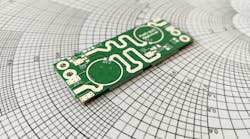Comparing Load-Pull Testing Methods
Load-pull measurements are a class of non-50-Ω measurements used during the design, model extraction, and performance testing of various RF/microwave devices. A main topic of discussion with load-pull testing is the evaluation of amplifier designs in a large signal sense. Load-pull testing essentially consists of taking signal measurements from the reflections of a device while a device is connected to a varying load.
This type of testing reveals the behavior of a device under varying load conditions, which is often essential for designs that may face a wide range of load impedances in practice. We can also look at it as measuring the response of a two-port device under test (DUT) as a function of load impedance.
The results of load-pull testing are several sets of data, consisting of measured a- and b-waves, as well as other parameters that can be calculated from the results. These parameters include gain, power, and efficiency. The large-signal input impedance of the DUT, power-sweep curves at various impedance states, and the iso-contours of the output power can also be plotted in real time during the measurements.
Typical load-pull testing involves a signal source, some type of signal-measurement equipment, and a variable load/tuner that can handle the DUT’s operating power. Several types of signal-measurement equipment can be used, such as spectrum analyzers, RF power meters, vector receivers, and so on. The type of source, tuner, and receiver determines the methods of testing, each having its advantages and disadvantages. In the following sections, we’ll outline those for the various methods.
Basic, Traditional, and/or Scalar Load Pull
These typical variations on load-pull testing involve the use of a signal source, input tuner, device under test (DUT), output tuner, and RF power meters. What you end up with is a relatively simple, and potentially low-cost, setup that’s highly modular and can readily be adapted to high-precision instruments.
The instrumentation is generally all scalar in nature; a network analyzer is required to yield vector-based parameters. In these basic types of load-pull testing, the actual delivered power is unknown due to impedance mismatches between the source tuner and DUT. De-embedding to the DUT plane is required.
Vector-Receiver (Real-Time) Load Pull
The base element of vector-receiver load-pull testing is, of course, a vector receiver. The test setup also calls for a signal source, source tuner, and input tuner. Measurements in this scenario are referenced to the DUT plane, which means that no de-embedding is necessary.
Vector-receiver testing can measure available and actual power levels. In addition, users can make vector measurements such as the distortion incurred in converting amplitude modulation to phase modulation (AM/PM). Other parameters measurable with vector-receiver testing include harmonic and intermodulation distortion. However, it’s not possible to measure modulated signals.
While vector-receiver load-pull testing avoids inaccuracies introduced by impedance tuners, the use of narrowband ADCs limits its wideband signal-decoding capability. Also, couplers are required between the signal source and DUT to reduce achievable voltage standing-wave ratio (VSWR) to the DUT.
Open-Loop Active Load Pull
Open-loop active load-pull testing is much like vector-receiver load-pull test, with the main difference being that mechanical impedance tuners are replaced by active tuning chains made up of signal sources with magnitude- and phase-control circuitry. Such test setups may be modified to enable harmonic load pull by adding a multiplexer, passive components, couplers, and combiners.
With open-loop active load-pull test, gamma levels (gamma being the voltage-reflection coefficient near the load, which is derived from the load and source impedances) of greater than one can be reached for very large VSWR measurements.
Such test setups offer speed advantages compared with mechanical impedance-tuning methods. They may also be more readily adapted to probe stations. On the other hand, it’s a relatively expensive test method compared with other load-pull methods. And, as with the vector-receiver method, it’s not possible to measure modulated signals.
Hybrid Load Pull
Hybrid load-pull methods include active and passive techniques. Both traditional passive mechanical tuners and active-injection load-pull systems have pros and cons. While mechanical tuners are simpler, less costly, and can handle high power levels, they also present difficulties in overcoming the losses that limit measurement of the VSWR. Meanwhile, active systems are fast, capable of reflected to forward-traveling wave ratios of 1, and are easily integrated for on-wafer harmonic measurements. On the other hand, high-power setups require more costly band-limited amplifiers.
Thus, hybrid load-pull methods represent an attempt to mitigate some of the disadvantages of each distinct method by combining active and passive tuning in the same system. With passive mechanical tuners in play, high-power reflected signals at the fundamental frequency need a much smaller active-injection signal and therefore much smaller amplifiers. This overcomes the losses inherent to mechanical tuning and enables achieving a2/b2 = 1.
Also, because power levels at harmonic frequencies are often much lower than the fundamental, a hybrid approach enables use of less-costly wideband amplifiers with active tuning to achieve active harmonic load pull with a2/b2 = 1. However, this approach leads to a mixed-cost and mixed-complexity test setup.
Mixed-Signal Active Load Pull
In a mixed-signal active load-pull setup, wideband analog-to-digital converters (ADCs) and digital-to-analog converters (DACs) are combined with upconverters and downconverters to enable wider-bandwidth operation. Benefits include faster measurement speeds and wideband impedance control. In addition, one may generate and measure modulated signals with bandwidths greater than 100 MHz.
Peter McNeil is Marketing Manager at Pasternack.
